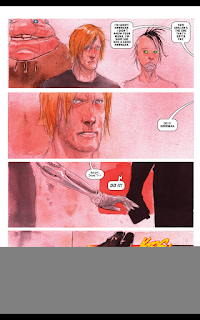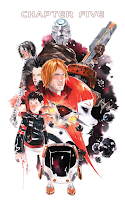
Descender vol. 2, like the
first instalment of this galactic saga, is a graphic novel with amazing visuals and an entertaining story. It is like one of those comfort-foods that you want to eat over and over again because, although it is not gourmet, original or new it tastes good, warms your belly and makes you feel good.
I'm always mesmerised by
Nguyen watercolour and drawing mastery and artistry. I love his use of colour and the way he creates lights an shadows using positive/background space. I love how good he is a creating landscapes and characters that can be painted with great detail or just sketched and deconstructed but, visually, still fully there. That is the case of his long distance images and background crowd images; the more you look at them the more they look like blotches of colour, but they are masterly shaped to create the illusion of a full image. Like in
Descender 1, Descender 2 has a cohesive colour palette, with colours and hues that are consistently used, some of them are there to depict the environment where the action is happening, but there is a preference for different hues of white, blue, pink and dark greys, with other bright colours popping up secondarily, like red and orange. I don't know if it is a coincidence, but a dark hue of pink is always in the image when Tim-21 experiences special moments in the story. Descender 2 story has more action than
Descender 1 so Nguyen plays more with the composition and layout of the vignettes to create dynamism and tension. Like in the previous volume, memories from the past are drawn in sepia tones with a superposition of scenes or developed scenes that have no vignettes; that is the way the mind and memory work -- as an amalgamation of images, words and feelings that are never square or structured. If you are into the Arts you will linger on each page, slowly sipping the watercolour work and Nguyen's artwork.
Once again the typography used in the book is very dynamic with different fonts being used to differentiate noise and ambience sounds, machine speech, robot speech, human speech, static signing, informative narration text and so on. This enhances the reading and makes the text more engaging and enjoyable.
As I mentioned for
Descender 1, I love
Lemire but I don't think Descender is his best work. Descender 2's narrative, character's depiction and dialogues are still science-fiction déjà vu and cliches. Some characters are crowding the pages without contributing to anything and wasting a time and space that could be devoted to a more in-depth depiction and analysis of the main characters. Descender 2 is better at doing so than Descender 1, though, as there is a bit of more digging into who the characters are, albeit superficial and not deep enough to create round unique characters that don't remind you of anything you haven't seen or read before. Some of the characters that were a bit annoying, distracting and unnecessary in volume 1 are toned down and almost gone in volume 2, like Driller the Killer. However, we see others occupy that same annoying spot, like the funny-ugly predictable Blugger in volume 2. Is he necessary to the story? Does he contribute to the story? To me, he doesn't, at least so far. The same happens with some of the dialogues, which are uninspired and a bit blah, and heard gazillion times in any other comic on planet earth. I found a bit ridiculous calling Effie the Queen in Between, jeez, I would have expected a bit of more creativity, a one word name that means just that...


On the sunny side of things, the story seems to follow places that, a priori, we are lead to think that it would not happen. Like Andy popping up. We, or at least I, feared that Tim-21 quest would be met with disappointment, but Andy pops up in this volume and there is a great joy and intrigue. Andy is perhaps the most developed character in the story so far and I am intrigued about his motives. We get to meet some of the leading robots known as the harvesters, enter their mechanic moon, and get to know who they are, what they want and what they believe in. I enjoyed the mix of Huxley meets New Age beliefs that the leading robots have; there is a bit of gold buried there and I hope we dig it out in the next volume. Although there aren't oneiric images in this volume, some of them are oneiric-like, especially those related to the fall into Planet Phages, and very lovely. Finally, the story touches many interesting important themes: self-identity, individuality, race, alterity, ethical behaviour, what life is, what being human means, and what makes us connect. The more I read Descender, the more I see it as a quest for the ideal brotherly love and for connection, whatever form this might take and whomever is the being one connects with. The worlds in the Descender galaxy are multifaceted and interesting despite the flaws of the story.
The ending of this volume, although not a cliffhanger, gets me interested, and, once again, I will be buying the next volume hoping that the story follows unexpected paths, that we get some u-turns and surprises and that some characters have more depth, and being sure that Nguyen's artwork will keep me going no matter what.
I read this book it on Comixology and the digital copy is fantastic. It makes you appreciate all the details of the artwork, and even the ruggedness and pores of the paper used for the paintings. One gets the impression of having the original in front of the eyes. I love that touchability of the images.

















































